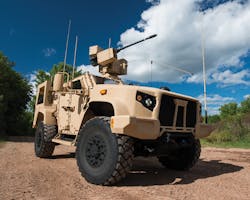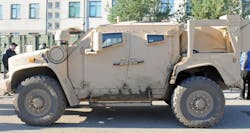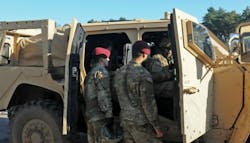One of the more interesting and indeed famous motorized vehicles in history is the Jeep; a “jack-of-all-trades” piece of military equipment that became a legend in its own time and eventually spawned a civilian version that, to this day, still holds iconic off-road status in the automotive world.
The contemporary successor to the fabled jeep is the “High-Mobility Multi-purpose Wheeled Vehicle,” or “HMMWV,” which eventually became known as the “Humvee.”
For over 30 years now, the Humvee has, in the words of Sgt. Corinna Baltos with U.S. Army’s 24th Press Camp Headquarters in Rukula, Lithuania, become the “go-to vehicle” for U.S. forces wishing to put “both boots and tires on the ground.”
Like the World War II-era jeep, the “Humvee” has become a “cultural icon” as well, she said. [You’ll see a little farther down why Lithuania is an important location in this story.]
And now it, too, is being retired and replaced by a “new Jeep” of sorts: the Light Combat All-Terrain Vehicle or L-ATV, built by Oshkosh Defense, a division of Oshkosh Corp.
The L-ATV is part of the $6.7 billion Joint Light Tactical Vehicle (JLTV) program awarded in August last year that is designed to replace a large portion of the legacy HMMWV fleet within the U.S. Army and Marine Corps with a light tactical vehicle that boasts in Oshkosh’s words “far superior protection and off-road mobility.”
Oshkosh said expects to deliver approximately 17,000 such vehicles and sustainment services during its contract period, though the new L-ATV won’t be truly “fielded” by U.S. military units until 2019.
So remember Sgt. Baltos from earlier? She covered field testing conducted with an L-ATV by paratroopers from the 2nd Battalion/503rd Infantry Regiment within the 173rd Airborne Brigade in Lithuania – a unit known as “The Rock.”
Why are they doing such testing? Because paratroopers are going to be the first units to receive the L-ATV as it is light enough to be transported by helicopter.
“We found that in Afghanistan the up-armored HMMWV was too big and heavy, and it lost a lot in performance,” noted Lt. Col. Rob Barnhill, product manager-systems integration with the Army’s Joint Program Office (JPO).
“We wanted to develop a truck with better underbody protection, and load protection, but one that could still put 3,500 lbs. of payload in it,” added Col. Shane Fulmer, the JPO’s product manager for systems integration. “This vehicle [the L-ATV] fits the bill.”
Oshkosh said the new L-ATV will come in two types: a four-passenger combat vehicle and a two-seat combat support vehicle. There’s also an L-ATV utility variant, with a cargo-carrying capacity of 5,100 lbs., is designed to provide mobility for loads such as containers, pallets and break bulk cargo in a wide range of operating environments and threat levels, Oshkosh noted.
In addition to hauling cargo, the L-ATV utility variant can be outfitted as a shelter carrier to carry standard shelters for communications systems, on-board electronics and other functions, the company added.
This “new Jeep” didn’t just spring into existence overnight, either; it results from a nearly 11-year design and development process, Oshkosh noted:
- 2005: Oshkosh begins developing its TAK-4i independent suspension system;
- 2007: Oshkosh develops the Light Combat Tactical Vehicle (LCTV) technology demonstrator;
- 2010: The Oshkosh LCTV completes the Baja 1000 desert off-road race; the first military-class vehicle to do so;
- 2011: Oshkosh evolves its design and introduces L-ATV variant within its JLTV platform;
- 2012: U.S. Government awards Oshkosh one of three JLTV Engineering and Manufacturing Development (EMD) contracts;
- 2013: Oshkosh builds its JLTV EMD prototypes and delivers them to the U.S. Army for testing and evaluation;
- 2014: Oshkosh’s JLTV prototypes successfully complete all requirements, testing and evaluation;
- 2015: Oshkosh is awarded the JLTV Production contract.
It is interesting to note that L-ATV can also be equipped with a ProPulse hybrid diesel-electric drive train with 70 kilowatts of on-board and “exportable power” to boost its functionality, efficiency and fuel economy.
“Looking ahead, future battlefields will generate an unpredictable combination of terrain, tactics and threats," noted Oshkosh Defense President John Bryant, who is also a retired Marine Colonel. "Our JLTV and M-ATV platforms can be configured with the protection and mission equipment to support both defensive and offensive operations outside-the-wire.”
That’s some kind of new jeep, let me tell you.


